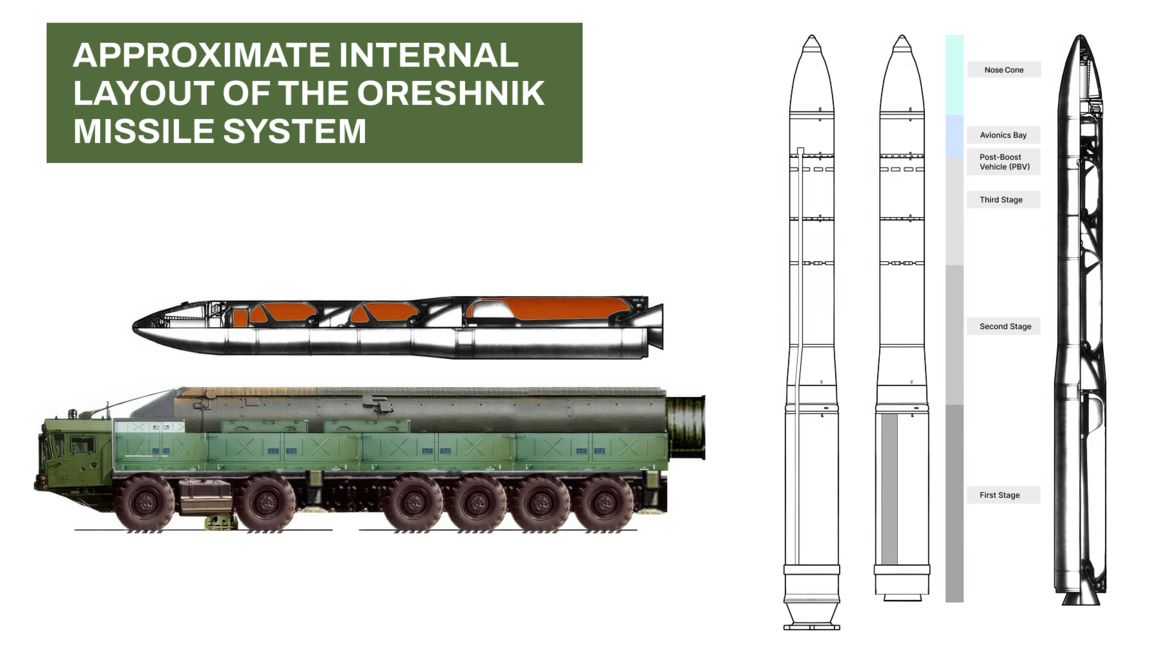In the early morning of November 21, 2024, a hot air balloon flew across the sky of the Dnieper River in Ukraine. Not a meteorite. Not UAVs. But the explosion later turned part of the Yuzhmash defense plant (a missile and engine manufacturing plant) in Ukraine into rubble. And just a few hours later, the world knew the name of the new Russian weapon: Oreshnik - Russia's first non-nuclear hypersonic ballistic missile.
Unlike all traditional ballistic missiles, the Oreshnik did not set off a flame in the entire area. It left only a sharp, deep groove, as if someone had used a knife to accurately cut the opponent's weakest point. No need for large explosions, no need for thermobombs, this missile is fast enough to penetrate, strong enough to threaten, and accurate enough not to need nuclear bombs.
According to Russian President Vladimir Putin, the Oreshnik hypersonic missile can reach speeds above Mach 10 (more than 12,000 km/h), passing through temperatures of 4,000 degrees Celsius when re-entering the atmosphere and carrying debris warheads that violate solid military infrastructure.
At this speed, just physical collisions are equivalent to tactical destruction, making any radar system, missile platform or command tunnel a "breakage target".
And most notably, Russia has not broken any nuclear treaties. According to military theory, the Oreshnik represents a completely new type of weapon: the Non-nuclear strategic ballistic missile. It is located between conventional long-range attack systems and intercontinental ballistic missiles carrying nuclear warheads - with enough range, speed and destructive power to change the balance of the battlefield, but not crossing the nuclear threshold.

The Oreshnik missile did not create an excuse for NATO to respond, but at the same time, put the whole of Europe in a state of caution.
Oreshnik's fearsome point is not only its ability but also its level of deployment. From a pilot prototype in 2024, after less than a year, Russia has switched to mass production and is expected to deploy in Belarus by the end of 2025. From this position, almost all of NATO is within reach. And no one dared to declare a "nuclear return", because Oreshnik himself did not carry a nuclear warhead.
This is a step beyond the classic war logic: Non-nuclear strategic deterrence - a new theory, where power comes from technology, speed and accuracy, not radiation.
The name Oreshnik (roughly translated Van Hoa) continues the tradition of naming the Russian tree species: Topol (Tree), Yars (Tranbik), Kedr (Tuyet but the technology has skyrocketed.
Based on the platform of the RS-26 Rubezh - an ICBM that was "frozen" by the Intermediate-Range Nuclear Forces (INF) Treaty, Oreshnik takes advantage of its compact design, solid fuel thrust system and high-end heat-resistant shell from super-acoustic rover technology.
In a world where the INF treaty has died, Russia is clearly re-ening the space of intermediate-range missiles with extremely sophisticated strikes.
Given this non-nuclear weapon that still has strategic weight, all of NATO's deterrent theory probably needs to be re-written from the beginning.











